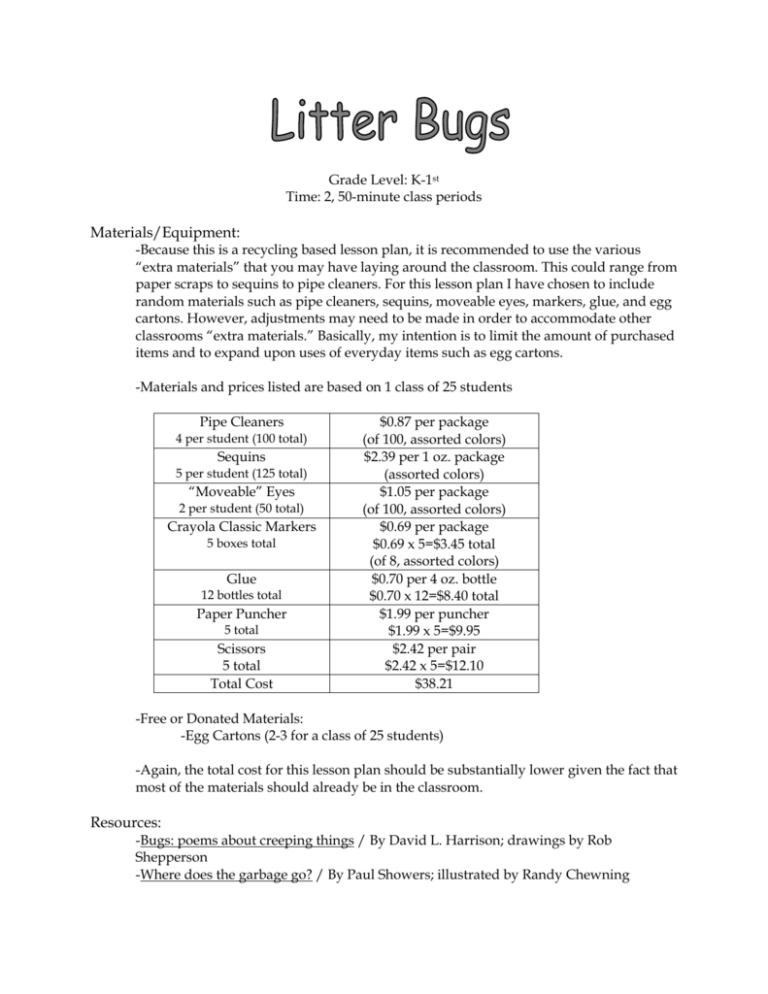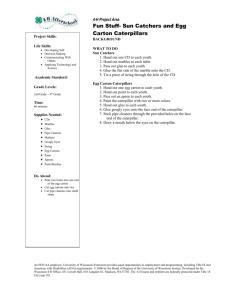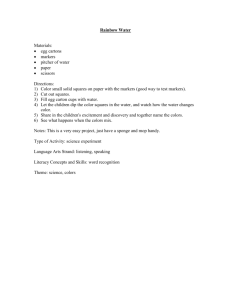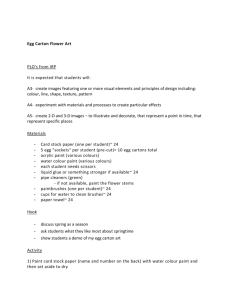File
advertisement

Grade Level: K-1st Time: 2, 50-minute class periods Materials/Equipment: -Because this is a recycling based lesson plan, it is recommended to use the various “extra materials” that you may have laying around the classroom. This could range from paper scraps to sequins to pipe cleaners. For this lesson plan I have chosen to include random materials such as pipe cleaners, sequins, moveable eyes, markers, glue, and egg cartons. However, adjustments may need to be made in order to accommodate other classrooms “extra materials.” Basically, my intention is to limit the amount of purchased items and to expand upon uses of everyday items such as egg cartons. -Materials and prices listed are based on 1 class of 25 students Pipe Cleaners 4 per student (100 total) Sequins 5 per student (125 total) “Moveable” Eyes 2 per student (50 total) Crayola Classic Markers 5 boxes total Glue 12 bottles total Paper Puncher 5 total Scissors 5 total Total Cost $0.87 per package (of 100, assorted colors) $2.39 per 1 oz. package (assorted colors) $1.05 per package (of 100, assorted colors) $0.69 per package $0.69 x 5=$3.45 total (of 8, assorted colors) $0.70 per 4 oz. bottle $0.70 x 12=$8.40 total $1.99 per puncher $1.99 x 5=$9.95 $2.42 per pair $2.42 x 5=$12.10 $38.21 -Free or Donated Materials: -Egg Cartons (2-3 for a class of 25 students) -Again, the total cost for this lesson plan should be substantially lower given the fact that most of the materials should already be in the classroom. Resources: -Bugs: poems about creeping things / By David L. Harrison; drawings by Rob Shepperson -Where does the garbage go? / By Paul Showers; illustrated by Randy Chewning Purpose of Lesson: -This lesson plan is important for young children because: -The issue of recycling is something that affects their daily lives and will greatly impact their future -Showing the students that material such as sequins, egg cartons, and pipe cleaners can have more than one use, thus opening their eyes to the possibilities surrounding other media and everyday objects -What are the goals for this unit? -My main goal for this unit is to help raise an environmental awareness in young children. Children should be shown that meaningful and purposeful art does not need to be created using only brand new materials; reused or recycled materials may also be implemented into a work of art. -I will be implementing 3 of the 6 National Standards into this lesson plan. -I will be teaching the students how to color on egg cartons, while also applying various objects to create a litter bug. -What should students be able to do by the end of this lesson? -Students should be able to recognize the reason for using recycled materials in this lesson. They should be able to utilize recycled, reused, or “found” objects in their creation of the litter bugs. Objectives: - During this lesson, students will be able to: 1. Identify various bugs 2. Apply a small object to an egg carton 3. Apply marker to an egg carton 4. Explain/demonstrate why it is important to protect our environment - Students’ understanding will be evaluated via completion of a litter bug (using primarily reused or recycled materials) and by performing a short skit demonstrating what they have learned. Interdisciplinary Connections: -Science -Students will be given information on issues relating to their natural environment such as the importance of recycling -Drama -Using their newly created bugs, students will be acting out brief skits demonstrating what they have learned about the importance of recycling National Standards: -Several of the K-4 National Standards that I will be implementing into this lesson plan include: -Standard #1: Understanding and applying media, techniques, and processes -Students will be applying marker to egg cartons -Introduction of atypical uses for materials such as sequins and pipe cleaners -Standard #5: Reflect upon and assess the characteristics and merits of their work and the work of others -Students will be allowed to work socially in the creation of the individual bugs -Bugs will be presented in a way that attracts attention via a brief skit performed by small groups of students -Standard #6: Make connections between visual arts and other disciplines -Students will be learning about the importance of recycling and construct their own “litter bug” (Science) -Students will act out what they have learned about the impact of recycling on the environment (Drama) Vocabulary: -Terms that I will present during this lesson plan include: -3-D/sculpture -Recycle/Reuse -Detail Instructional Procedures: -Prior to Class Period 1 -Check out Bugs: poems about creeping things / By David L. Harrison; drawings by Rob Shepperson from the library. -Cut out the twelve different “compartments” in 2 standard egg cartons (preferably a cardboard carton). -Move tables to form one large group for students to sit in. -Place one “compartment” at each seat. -Place small containers of markers at several different spots on the tables. -Class Period 1 -Greet students as they walk into the classroom and direct them to the carpet area for story time and discussion. -Sitting in front of the students, begin asking them questions such as “Does anyone know what the word ‘recycle’ means?” “Can anyone tell me why we recycle?” -Give a simple definition for the words ‘recycle’ and ‘reuse’ and explain the differences. -Ask students to be thinking about the word recycle as you read the book Bugs: poems about creeping things. -Read the book. -While reading, point out various parts of a bug such as the different colors, antennae, or the many legs of some bugs. -After the book, ask students to raise hands and list off different things they noticed about the bugs. -Ask students is they know what “3D” or “sculpture” means. Explain the definition and that they will be making their own 3D object. -Inform the students that they will be creating their very own litter bugs using primarily recycled or reused materials (the litter bugs do not need to resemble an actual bug, but may be an imaginary one instead). -Direct students to their assigned seats at the tables based on what they are wearing (example: anyone wearing green may go to their seats, anyone wearing stripes may go to their seats). -Let students know that they will be using the markers on the tables to color each of the egg carton “compartments,” AKA the body of the bug. -After students have been coloring for a few minutes, get their attention and quickly demonstrate how to use a paper hole puncher. Let them know safety procedures and that they can use them to create holes for their bugs’ legs at a later time. (Students may need assistance in using the paper hole punch on the cardboard. -Let students work a little while longer. -As class time comes to an end, instruct students to place all lids on the markers and place them back in their containers. -Have them leave their egg cartons at their seats so you can write their names on the inside after class. -Line the students up at the door and let them know they will be putting eyes, legs, etc. on their bugs next time! -Prior to Class Period 2 -Move tables to form one large group for students to sit in. -Place each student’s colored egg cartons at their assigned seats. -Place bottles of glue and bowls of sequins, moveable eyes, and pipe cleaners around on the grouped tables. -Class Period 2 -Greet students and direct them to the carpet area for discussion -Briefly cover what was learned the last time they met and ask questions such as “Does anyone remember what the word ‘recycle’ means?” “Can anyone remember why we recycle?” -Inform students that they will be continuing to work on their bugs by attaching legs, arms, eyes, etc. -Also inform them that they will be getting into groups of 3-4 (groups may be assigned by instructor) to create a brief “play” telling others how they can help save the environment. Let them know they can use any information that they learned from the book read last class or from what has been discussed in class so far. The plays will take place after all of the litter bugs are completed. -Ask students if anyone knows what the word “detail” means. After a few answers from the students, give a kid-friendly definition they can remember. Explain to them that they will be adding their own details to their litter bugs. -Demonstrate how to attach the pipe cleaners (using the holes created last class with the paper puncher), sequins, and moveable eyes to the egg carton. -Ask students if anyone wants to share what they are going to make their bug look like. -Let students know that there are bowls of materials sitting on the tables and that those bowls have small items that should not be thrown around or put in their mouths. They should only take as many as they need and leave the rest in the bowl for the other students. -Also let them know there are scissors at the tables to cut the pipe cleaners. Go over any necessary safety procedures regarding scissors. -Direct students to their seats based on what they are wearing (example: anyone wearing orange may go to their seats, anyone wearing a sweatshirt may go to their seats). -“Nature” music may be played while children are working. -As the students are finishing up, remind them to pick up any stray sequins, moveable eyes, and pipe cleaners and return them to the appropriate container. -Let students get into their groups for (at the most) 5 minutes to figure out what they will say for their play. -Have each group present their play, litter bugs, and the knowledge they have accumulated thus far. -If time allows, go over as a class what they have learned about the environment and how they can protect it using art, such as creating art to raise awareness for environmental issues. Assessment: -The checklist assessment technique will be utilized for this lesson plan. It should be completed at the end of the lesson. Student Name:___________________________ Date: _________________ Student successfully created a litter bug using an egg carton compartment and other various objects Student showed newly gained knowledge concerning environmental issues Student showed proper use of scissors, markers, and glue Student participated in a play with other students Student worked well with others in small groups Comments: Yes No






